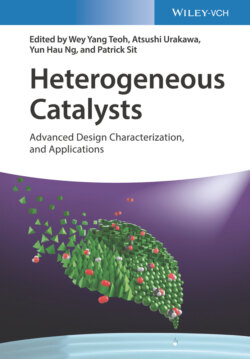Читать книгу Heterogeneous Catalysts - Группа авторов - Страница 73
6.1 Introduction
ОглавлениеSupported noble metal catalysts have been widely used in the production of chemicals [1], the remediation of environmental pollution [2, 3], and the processing of fuels [4, 5]. However, it is still desirable to increase the efficiency of supported noble metal catalysts due to the high prices and limited supplies of noble metals. To achieve this goal, one may attempt to design better supported catalysts by decreasing the content of the noble metals while maintaining their high catalytic efficiency. Thus, the sustainability of related industries can be improved, and the costs of production can be minimized.
Liang et al. gave an example to illustrate the advantage of supported noble metal catalysts over bulk metals (Figure 6.1) [6]. Assuming that the price of pure gold is US$ 38.1 g−1, a gold brick with the dimensions of 20 × 10 × 5 cm3 is worth approximately US$ 736 000. For comparison, if a common brick (20 cents) with the same dimensions is coated with an atomic ultrathin layer of gold (1 cent), the total value of the brick is only 21 cents (if the cost of coating processing is not counted), much lower than that of a gold brick. Thus, dispersing noble metals as ultrafine nanoparticles (NPs), clusters, or single atoms (SAs) on solid supports is effective for the efficient use of noble metals and the minimization of catalysts' costs. Then what is the effect of downsizing metal NPs on the catalytic activity of supported metal catalysts?
Figure 6.1 Prices of different bricks with a size of 20 × 10 × 5 cm3. (a) A gold brick, (b) a common brick, and (c) a common brick coated with a single atomic layer of gold atoms.
Source: Liang et al. 2015 [6]. Reproduced with permission of John Wiley & Sons. (See online version for color figure).
Catalytically active sites (CASs) are the atoms where the chemical reaction actually occurs. This concept was introduced by Taylor [7]. Although the precise identification of CASs of supported metal catalysts is very difficult due to the quantum size effect [8–10] and the structure‐sensitive geometric effect [11, 12], CASs are generally the surface atoms in an unsaturated coordination environment [13–15]. When downsizing metal NPs, the number of surface atoms increases substantially, and the metal NPs expose more defects and active sites, thus leading to higher catalytic activity [13–15]. Forming SAs on the support is the most efficient approach to utilize metal atoms in a supported metal catalyst.
Single‐atom catalysts (SACs) are catalysts in which the active metal species either exist as isolated SAs stabilized by the support or exist by alloying with another metal [16–18]. Since the concept of SACs was proposed, research on SACs has progressed rapidly to obtain a better understanding of sample preparation and characterization, the role of support, the strong metal–support interactions, and the catalytic mechanisms. Herein, we review some of the recent research on SACs, focusing on various preparation methods. Future challenges and opportunities are also discussed.
